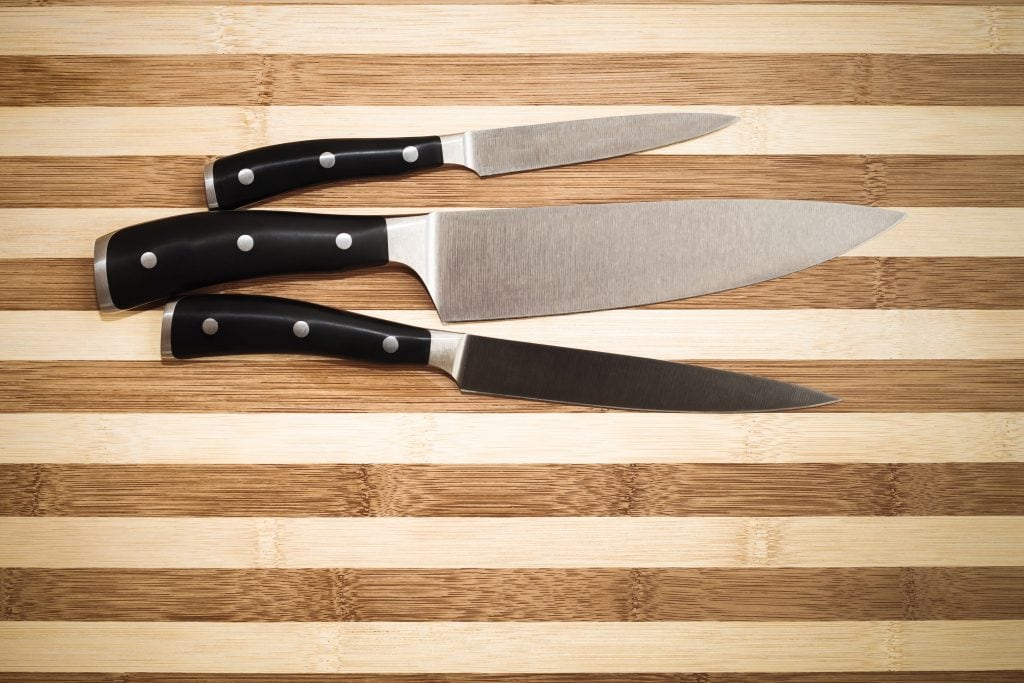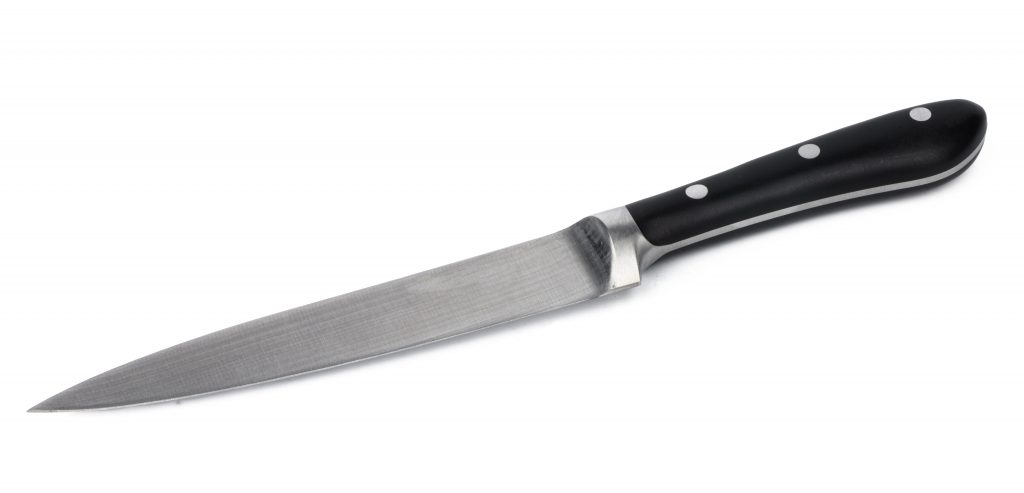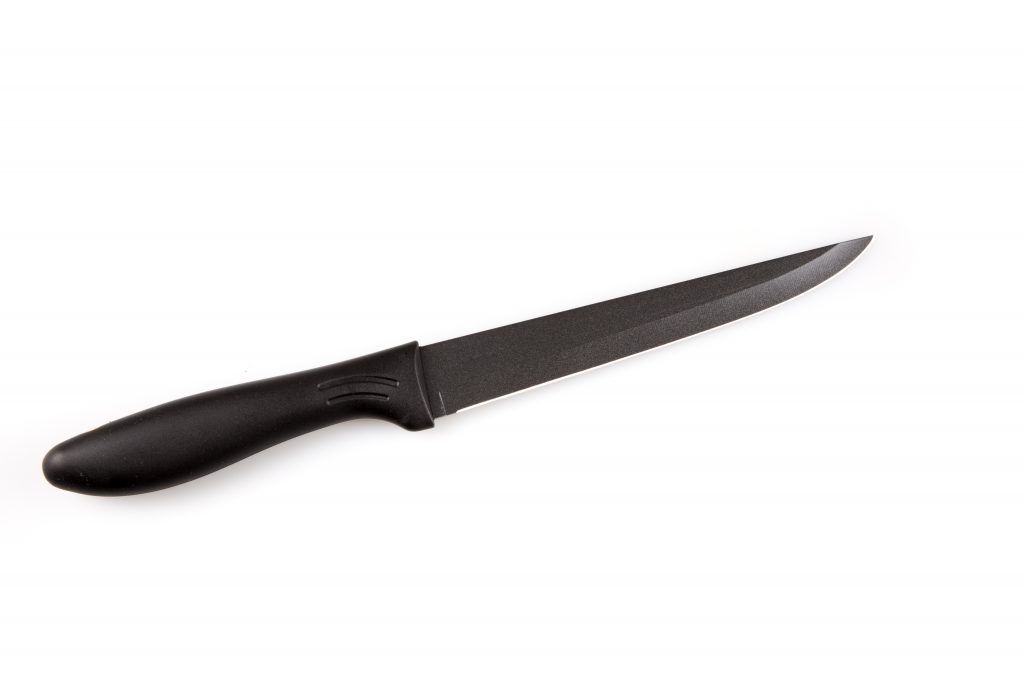Searching for the best utility kitchen knives can feel like wading through a quagmire if you don’t know where to look. That’s where we come in. This page is our comprehensive guide to finding a utility chef’s knife that works for you.
The type of chef you are and the work you do in the kitchen will determine the option that works best for your circumstances. We’ll run through the fundamentals in this article to help you buy with confidence.
We’ll cover balance, tang, durability, and so much more.
What is a utility kitchen knife?

The terms ‘chef’s knife’ ‘paring knife’ and ‘utility knife’ are often used interchangeably but this is something of a misnomer. While all of these knives share similarities, they are distinct tools that serve their own purposes. Understanding what sets them apart from each other will help you perform at your best with the tools you have available.
In short, a utility knife is a small, precise knife that’s excellent for more detailed, intricate work in the kitchen. It’s larger than a paring knife but smaller than a chef’s knife. It’s designed to be versatile for a variety of different tasks.
Some models feature a sharp tapered tip that allows for even more detailed work.
This kind of knife can tackle a broad variety of different kitchen tasks including:
- Making precise cuts and trims in meat
- Chopping and preparing smaller vegetables
- Preparing fruits for garnish or display
- Working with more delicate foods like shallots or garlic
If your regular chef’s knife feels too large or unwieldy for the task at hand, a utility knife could be the perfect fit. In the same vein, larger, more heavy-duty tasks will be more difficult with a utility knife.
This includes tasks like:
- Slicing bread
- Cutting through bone or denser squashes
- Carving meat or other foods
- Cuts that require a long or broad blade
Do you really need a utility kitchen knife?
Do you really need an oven, or a stovetop, or pans? While it’s possible to survive without a utility knife in the kitchen, it can make a huge laundry list of different tasks much easier. If you’re interested in improving as a chef, it’s important to have the right tools for the job.
Certain fruits, vegetables, and herbs can bruise very easily and leech their flavor into your cutting surface. Cutting with precision will allow you to treat your ingredients with the respect they deserve.
How to hold and use a kitchen utility knife?
Once you’ve found the right knife for you, it’s important to make sure that you’re using it properly in the kitchen. We outline a few tips below to help you avoid injury and work efficiently. Be sure to check out our step-by-step guide a bit further down this page.
Keep the following in mind when using a utility knife:
- Your fingers, clothing, and other body parts should be kept clear of your cutting line at all times
- Always cut on a flat, even surface or with great control in your hands
- You might like to keep your index finger on the spine of your blade for added control
- Some chefs use their thumb on the spine instead
- Use a utility knife with the right balance and handle size for you
- Keep your work surface clear and safe
- Stand upright and stay alert when working
Step by Step Guide
You might like to follow these basic steps when working.
- Check your work surface and make sure it’s clear, flat, and even
- Pick the right utility knife for the task at hand
- Briefly think through the cuts you plan to make
- Stand upright and cut confidently without rushing
- Keep your index finger or thumb on the spine for added control
- Keep your fingers and body clear of your cutting line
- Maintain a controlled, but flexible wrist throughout
How to choose the best Utility knife for you?
There’s no one-size-fits-all approach here. Your experience, goals, and training as a chef will determine the utility knife that works best for you. Below, we discuss some of the main factors to consider when buying a new knife.
Price – How Much Does A Utility Knife Cost?
Most utility knives fall within the same relatively narrow price range. The hardness, handle design, brand, and overall quality can all affect the final price you pay. In general, expect to pay between $20 and $60 for a new utility knife.
It’s worth noting that some models can cost as much as $100+. The right choice for you comes down to your preferences and approach as a chef.
Dimensions – The Length & Weight of a Utility Kitchen Knife
There are two critical dimensions to consider here – length and weight.

The length of a utility kitchen knife
Typically when we talk about knife length, we’re talking about the length of the blade from the tip to the bolster. Some manufacturers will list a ‘total knife length’ and a ‘blade length’ online.
Most utility kitchen knives have blades somewhere between 6 and 8 inches long.
What Is the best length for a utility kitchen knife?
The length that works best for you will depend on the type of things you’re hoping to achieve in the kitchen. Think about the following when considering blade length:
- How delicate your cuts need to be (shorter tends to be better)
- How much mincing or chopping you plan on doing (longer can be better)
- How long the rest of the knives in your kitchen are
The handle length is another important factor to consider. Wherever possible, try to physically hold any product you’re considering and see how they feel in the hand. Your hand size and general preferences will determine the handle size that works best for you.
The weight of a utility chef knife
Personal preference plays a big role here. The weight of any kitchen knife will inevitably affect how it feels to use. It can also influence how effective it is at certain tasks. A heavier knife will be better at tough, more heavy-duty cuts but will be harder to wield for more intricate knife work.
Most utility knives weigh between 90 and 250g (3-9 Oz). Watch out for different measurement units depending on where you’re shopping; some brands use Oz instead of grams.
What is a good weight for a utility chef knife?
Again, this will depend on the type of work you’re doing and your preferences as a chef. For more intricate work, it’s best to aim for a slightly lighter knife. For more substantial cuts and chopping, a higher weight can be beneficial.
The Utility Knife Blade
The blade of your knife is one of its most important components. Utility chefs’ knives are designed to make intricate, precise cuts. For this reason, a thinner blade with a sharpened tip is usually best.

Blade Material – What material should a utility knife blade be made of?
In general, utility kitchen knife blades are made from one of the following:
- Stainless steel
- High-carbon steel
- Layered Damascus steel
It’s important to note that there are plenty of fantastic knives out there made from all of these materials; it’s best to consider each product on a case-by-case basis rather than be distracted by its materials alone. That said, we explore the broad strokes of each below.
Stainless Steel
- Very affordable
- Easy to clean
- Easy to sharpen
- Can be used for more flexible knives
- Can be slightly less durable
High-Carbon Steel
- Superior sharpness retention
- Better overall durability
- More expensive
- Prone to rust if not maintained properly
Damascus Steel
- Excellent sharpness and hardness
- Fantastic sharpness retention
- Attractive exteriors
- Very expensive
Learn how to remove rust from a knife blade and how to protect your kitchen knife from rusting.
Blade Length – How long should the blade of a utility kitchen knife be?
As mentioned above, the blade length you choose will depend on the type of work you’re hoping to achieve. Most utility blades are between 6 and 8 inches in length, although some outliers do exist.
The shape and tip design of a given product can influence its advertised length. This reading is typically measured from the knife’s tip to its bolster (the point before the handle begins). When deciding which length would be best for you, consider what kind of tasks you’re most likely to be doing.
Very precise garnish work is usually executed in the hand. For the type of work, a shorter blade tends to work best.
Repeated tasks like chopping, mincing, and cutting can all take place on an even cutting surface. In general, a longer blade can work well for these tasks.
Remember that your personal preference is a huge factor in decisions like these.
Blade Height/Width – How high/wide should the blade of a utility kitchen knife be?
The height of any kitchen knife is worth considering. If your knife’s blade is too thin/short, you may find that you bash your knuckles against your chopping surface while working. This issue is more common with standard chef’s knives, but it’s worth thinking about here too.
Taller blades are great for high-impact work. Shorter blades make intricate tasks easier.
For the more intricate tasks you’ll be doing with a utility knife, you’ll want to make sure your blade is tall enough to make the cuts you need while small enough to be handled effectively. Your hand size and personal preferences both play big roles here.
Average heights can vary wildly, but most utility knives fall somewhere between 2 and 4 inches in height.
Blade Flexibility – Should a utility kitchen Knife have a flexible blade?
Without sounding like a broken record, the flexibility you require in your knife will come down to the type of work you’re doing in the kitchen.
Flexibility in a kitchen knife can be useful for the following:
- Accurately filleting fish and some cuts of meat
- Efficiently slicing rind fruit like watermelon
- More precision for certain cuts
- Reducing wastage when prepping some foods
Keep the following in mind about flexible blades:
- They can be a bit harder to sharpen effectively
- They’re less useful for dense vegetables and tougher cutting jobs
- They can slip into inexperienced hands
A complete beginner might opt for a knife with a HRC (Hardness Rockwell C Scale) of around 56.
Blade Width/Thickness – How thick should a utility kitchen knife blade be?
Your priority with most kitchen knives should be speed and ease of use. This comes from cuts that take less pressure from the chef to accomplish. In general, thinner blades are better for this.
One exception here is for more heavy-duty tasks like cleaving.
Aim for a thickness somewhere around 0.8-1.2 inches if you’re a beginner. Remember that the thinner your blade gets, the shorter its lifespan becomes after multiple sharpenings.
Tang for utility kitchen knife
The tang of a kitchen knife is the unexposed part of the tool that runs through the handle. In general, a full-tang knife is your best bet for most kitchen knives as it allows for superior durability and safety while cutting.
We briefly touch on the different tang types below. If possible, check whether your tang is secured with adhesive, epoxy, bolts, or a combination of all three.
Full Tang
The best option in our opinion. It runs through the entire length of the handle for maximum durability. This does add to the weight and price of your knife.
Partial Tang
The tang terminates partway through the handle There are still some good knives with this design, but they may not last as long.
Rat Tail Tangs
Rattail tangs are much thinner than normal designs and are not built for regular or heavy use. They’re best avoided in utility knives in our opinion.
HRC for a utility kitchen knife
The Hardness Rockwell C scale is used to determine the hardness of kitchen knives. Harder knives hold their sharpness much better but are also more brittle. ‘Softer’ knives are more flexible for filleting and carving but can require more maintenance over time.
We recommend finding a utility kitchen knife with a HRC rating between 56 and 58.
Should a utility kitchen knife be Forged or Stamped?
A forged knife is made from a single piece of metal that is heated and beaten into shape. This process is quite labor-intensive and results in a heavier knife overall.
Stamped kitchen knives are made from a cut sheet of metal that is then heat-treated and shaped.
A few years ago, forged knives were the clear winner when it came to durability, with stamped knives existing as a cheaper alternative that didn’t last as long. These lines have been blurred in recent years.
Your best bet will be to judge each knife on a case-by-case basis. How does it feel in the hand and how is it rated for durability? What kind of warranty does it come with? These are the important questions to ask when shopping.
The utility kitchen Knife Handle

When it comes to your knife’s handle, grip comfort and balance are the two main factors to look out for. While there’s a mountain of variety out there, your hand size and preferences will play a huge role.
Look out for reviews that discuss comfort online.
Below, we explore the different parts of a kitchen knife’s handle.
Bolster
The bolster connects or ‘bridges’ your knife’s blade and handle. Handle length is often measured from the bolster to the butt.
Butt
The butt is the very end of your knife’s handle.
Tang
As explored above, the tang is the unexposed part of your knife that runs through the handle. A full-tang design is usually best.
Scales
The scales are the parts of the knife that attach to the tang to form a handle. They’re usually attached using rivets, adhesives, or both.
Balance – What’s the right balance for a utility kitchen knife?
Balance refers to the distribution of weight throughout the entire body of a kitchen knife. On a ‘perfectly balanced’ knife, it should remain stable when you rest the bolster against your finger.
When choosing an option that’s right for you, it truly comes down to how a product feels in the hand. If the handle or blade feels too heavy, chopping and delicate cuts can become challenging.
When shopping online, watch out for the following:
- Any abnormalities in blade length of handle length
- The overall weight rating for the knife
- Online reviews that mention balance
Maintenance and Care – How to maintain a utility kitchen Knife?
A well-maintained high-quality knife can stay useful for many years. For this reason, it’s important to choose options that are easy to look after.
In general, keep the following in mind:
- Harder knives need to be sharpened less often but may chip more easily
- The thinner the blade is, the less durable it becomes
- Many professional knives are hand-wash only
How to clean a utility kitchen knife?
This may surprise you, but it’s generally considered bad practice to clean any knife in the dishwasher. Even if the manufacturer describes its product as dishwasher safe, it’s still generally a good idea to hand-wash only.
The temperatures, detergents and dynamic action of most dishwashers can wreak havoc on your knife’s sharpness, adhesives, and handle.
In general, use moderate temperatures and mild soaps to clean your utility knife. This video from A.G Russell Knives covers cleaning and storage very well:
Are utility kitchen Knives Dish-washer Safe?
In short, all kitchen knives should be considered as hand-wash only. Your manufacturer can provide guidance about whether a certain product is dishwasher-safe, but even ‘rated safe’ knives can degrade in a dishwasher over time.
Honing & sharpening your knife, How to keep your utility kitchen Knife Sharp?
A high-quality knife should only need occasional sharpening. That said, it’s important to know what to do when the time comes.
Most knives can be sharpened using a whetstone. In short, the knife’s blade is run along with the stone at the correct angle to achieve a sharp edge. For most utility knives, an angle between 12 and 17 degrees will work. Coarser whetstones are used for knives that are very dull or thick.
Sharper, thinner knives (like your high-quality utility knife) should be started on a finer grain whetstone.
Beginners can hold a sharpening guide to help maintain the right angle when working.
Read now >> How to tell if a knife is sharp?
This video from Ethan Chlebowski is fairly long, but it covers knife sharpening in impeccable detail:
How to store a utility kitchen Knife?
Follow these best practices when storing your utility kitchen knife:
- Don’t store loose in a drawer with lots of other equipment
- Keep your knife dry and at room temperature
- Sheathe in the included cover or use a storage block like this one
- Try not to run the blade against the surface of your knife block as this can dull it over time
A magnetic wall holder is another great way to store knives
Conclusion
So, do you need a utility chef’s knife? We think the answer is a resounding yes. The versatility that comes with this kind of knife can be indispensable in the kitchen. Having the right equipment for the job will help you improve as a chef over time.
The main things to look out for will be the balance and blade length that works for you. These elements influence the overall ‘feel’ of a knife which is very important when working. Try to physically hold the knives you’re considering. Failing this, try out a friend’s or your own existing knives and take note of which shapes, weights, and sizes feel best for you.
Remember to keep the following in mind when shopping:
- Look for an HRC between 56 and 58
- Try to find a full-tang knife
- Assess each knife on a case-by-case basis; there are plenty of exceptions out there!
Whichever knife you choose, we hope it serves you well for many years to come!
Read now >> Utility Knives VS Paring Knives
